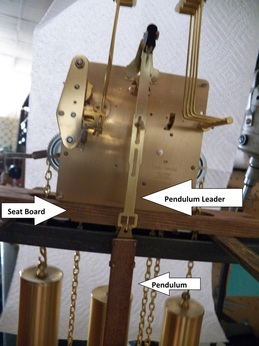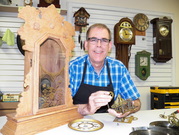|
First let’s talk about what can go wrong in a move. The number one problem that I observe is broken chime rods, followed by pendulum problems (broken suspension springs or dislocated pendulum leaders), and weight problems (weight chains that are off their sprockets, or tangled weight cables). Here are the steps I use when packing a clock to ship for moving: 
Once you have immobilized the pendulum, tape it securely to that backboard of your clock case, using painter’s tape. After your move, be sure to remove the tape as soon as possible to prevent damaging the wood finish. 3. Secure the pendulum leader: For grandfather clocks, use painter’s tape to tape the pendulum leader to the seat board or to the case. 4. Secure any chains or cables: If the weights hang from chains such as with cuckoo clocks and some grandfather clocks, you need to keep the chains from jumping off the sprockets during the move. To do this, insert a thin piece of wire or a twist tie through the links of each chain and then twist the wire tight. Put the wire through the links that are as close to the movement as you can reasonably get. If the weights hang from cables you want to prevent the cables from becoming tangled. Most grandfather clocks made after World War II have cable guards that usually prevent the cables from becoming tangled, but why take a chance? You can use Styrofoam blocks to keep the cables in place. Timesavers sells “Styro block for packing” (item number 23121). These items are inexpensive and generally superior to anything you can make. Place the block on top of the pulley so that the pulley rests in the slot. Wind the clock until the block is pressed firmly against the seat board. Then remove the weight. If you cannot use the Styrofoam blocks for some reason, use blue painter’s tape to tape the cables to the seat board, or tape the cables to the winding drums if your clock does not have cable guards.
5. Remove and pack the weights: Remember that the oil from your hands will tarnish brass to a chocolate brown. Wear gloves. The weights are lead or cast iron cylinders inside of thin brass shells. While the shells are all the same size, the weights are usually different. The weights are usually marked L, C, R for your Left, your Center, and your Right. If they aren’t marked, mark them on the bottom with a marker or tape before unhooking them from the clock. This will prevent confusion when you go to set the clock back up at your destination. When you have unhooked the weights, check that the weight hooks are tight. To do this, turn the hooks clockwise as if you were tightening a nut. The shells are very fragile and dent easily. Wrap them carefully with bubble wrap and pack them in a box so that they can’t roll around and be damaged during the move. 6. Secure the chime rods. For a smaller clock, put folded paper towels or newspaper between the chime rods and the case. For grandfather clocks, put wads of crumpled paper between the two banks of chime rods to prevent them from vibrating and tape them in place with painter’s tape. 7. For antique (prior to 1875) grandfather clocks only: Remove the movement: The seat board may only be held in place by gravity. Sometimes screws were added at a later date, but these don’t usually have a lot of support and will give way with a strong jolt. It is best to remove the movement, wrap inside a plastic garbage bag to keep it clean and box it up with plenty of cushioning packing material. If you use Styrofoam peanuts, make sure the plastic wrapping is tightly sealed so that no Styrofoam pieces get caught in the movement. Here is a helpful video by Antique clock specialist, Gary R. Sullivan to further illustrate. 8. Secure the bonnet or side panels: If your clock has a bonnet that slides forward off the clock, you can either remove it and pack it separately, or you can secure it to the clock with Saran Wrap or other plastic wrap. Take several wraps around the entire top of the clock so that the bonnet cannot slide off the clock. If your clock has access panels, use painter’s tape to tape the access panels to the clock case. 9. Wrap the case in a quilt or other soft material: You can protect the clock case from bumps and gashes in the moving van by protecting the surface with moving blankets. 10. Use a dolly to move the case into the moving van; store the clock upright in the van if possible. We hope you have a safe move! See my other articles "Setting up a grandfather clock" or "Hanging and setting up a wall clock" for guidance on setting up the clock again after your move.
9 Comments
3/8/2018 05:35:30 pm
My mom is moving into a new home and she wants to get her clock to her new home safely. She would benefit from knowing to secure the bonnet so it will not slide. Once she gets moved, she will get a clock restoration service to make sure there is no damage.
Reply
3/10/2018 11:07:26 pm
Make sure that you pack around the chime rods. Broken chime rods are the number one problem I see after a move. Good luck with it. Good luck with the move!
Reply
Deborah Jirsa
4/26/2018 09:21:36 am
Planning on moving an anniversary clock from Texas to Illinois. Do you know of a clock repair or service in Austin TX to pack it because it will have to be shipped? D. Jirsa
Reply
4/27/2018 10:10:42 pm
I don't personally know any clockmakers in Austin TX. The American Watchmakers Clockmakers Institute has a referal service on their website: https://members.awci.com/AWCIWEB/AWCISearch/MemberSearch.aspx. I see that they have one listing for Austin.
Reply
12/13/2019 01:52:06 pm
Thank you for your tip to wrap the case in a moving blanket to protect it from bumps and gashes. My father likes to participate in those self-storage auction wars and he found a huge clock in it the other day that he wants to get repaired. I'll pass this moving tip onto him so he can transport it safely to wherever he needs.
Reply
10/7/2020 09:27:30 am
I need to send my clock in for repairs. Thanks for the tip to box up my clock's large pendulum on its own. I'll find a place that will repair it through shipping because I might have COVID-19 and can't take it in physically.
Reply
5/5/2024 11:47:45 pm
Great post much appreciate the time you took to write this
Reply
Leave a Reply. |
Mike SarchetI am passionate about restoring and repairing antique clocks. In this blog I answer commonly asked questions about how to care for your clock. Frequently Asked Questions:
|
|
Email: mike@wiseowlclock
repair.com |
|


